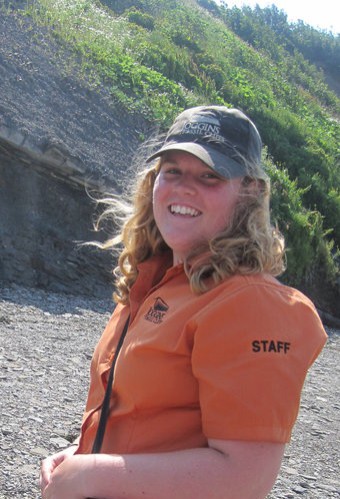Nicole Marshall

Oceanography & Earth Sciences
1st Class Honours
University Medal in Earth Sciences
B.Sc. (Honours) Thesis
Late Quaternary Variations of the Labrador Current in Flemish Pass
(PDF - 8.1 Mb)
Sediment drifts of alternating sand and mud, shaped by the Labrador Current in 1000 to 1200 m water depth, formed during the Late Quaternary in Flemish Pass, seaward of the Grand Bans of Newfoundland. These drifts, or contourite deposits, preserve Labrador Current flow variations throughout the last glacial cycle. Previous work in northern Flemish Pass shows that significant grain-size variations with time are influenced by the Labrador Current. During a CCGS Hudson cruise, 2011031 high-resolution seismic profiles and numerous sediment cores were obtained throughout Flemish Pass. A seismic profile and four sediment cores from southern Flemish Pass, an area not previously well studied, form the basis of this research. A transect of four cores was collected across the pass, including one core on the top of a prominent drift, the Beothuk Drift, located on the eastern side of southeast Flemish Pass. Core descriptions X-radiography, and down-core measurements of colour, grain size, X-ray fluorescence, P-wave velocity and bulk density measurements were used to correlate the cores and to provide an age model based on previous Heinrich layer identifications.
The grain-size variations, down-core and laterally, and changes in sedimentation rates provide evidence for flow variations of the Labrador Current in the Late Quaternary. Drift sedimentation between H2 (24 ka) and H1 (16 ka) had an approximate sedimentation rate of 170 mm/ka with a minimum of 61 ka/mm on the west of Flemish Pass. In the past 16 ka, there has been strong sediment partitioning across Flemish Pass with an approximate drift sedimentation rate of 260 mm/ka, decreasing to 16 mm/ka on the west.
Sortable silt percent (SS %) is used as a proxy for current strength. SS % prior to H1, and excluding H2, ranged from 32-41%, averaging 36%. After H1, SS % ranged from 43-57% with an average of 48%. This increase is SS % suggests that the Labrador Current has strengthened after deposition of H1. The highest SS % is 57%, at the top of the drift, suggesting that the Labrador Current is stronger today than it has been in at least the past 24 ka.
A 0.12 m thick interval of alkaline basaltic lapilli tuff is found 4 m beneath the seafloor in piston core 0022, between H3 (30 ka) and H2 (24 ka). No similar bed has been previously found in Flemish Pass, an area where hundreds of cores have been collected. A comparison of trace element geochemistry suggests that the basalt source is the Snaefellsnes Volcanic Zone in Iceland. However, the major element geochemistry suggests that the two are not related and that the core 0022 tuff does not originate from Iceland or Jan Mayen. The method of transport of the basaltic lapilli tuff found in core 0022 was likely ice-rafting by an iceberg or sea ice. A probable method of deposition was a rolling iceberg dumping the basaltic lapilli tuff onto the core 0022 location during a time of intermittent erosion on the seafloor.
Keywords: Labrador Current, Flemish Pass, Grand Banks, Beothuk, drifts, sortable silt, grain size, Heinrich, paleoceanography.
Pages: 103
Supervisor: D. J. W. Piper



